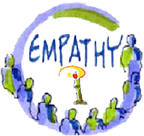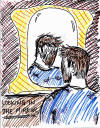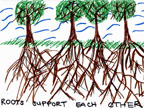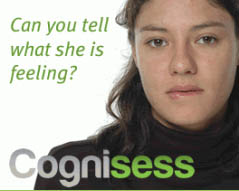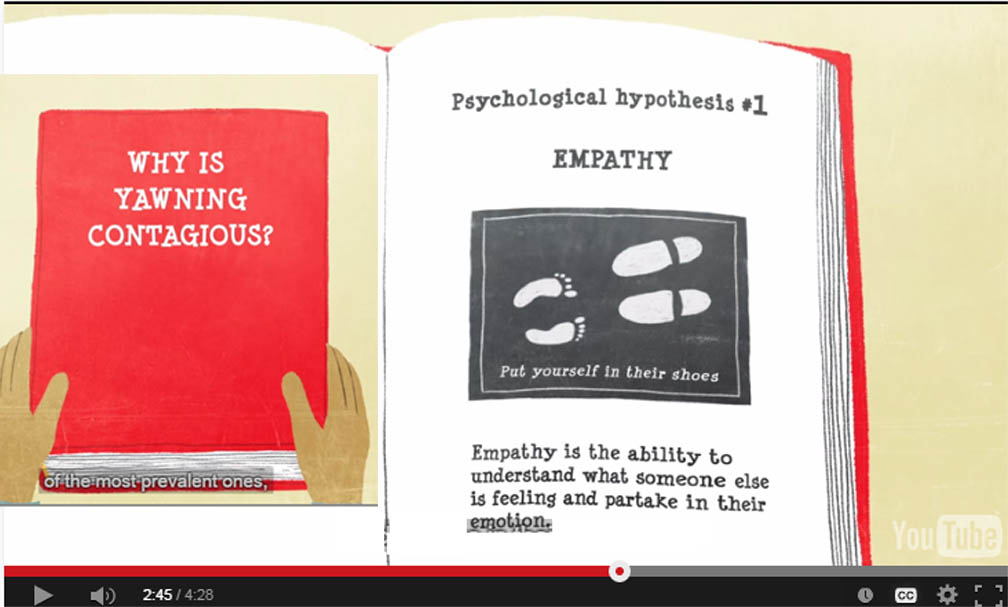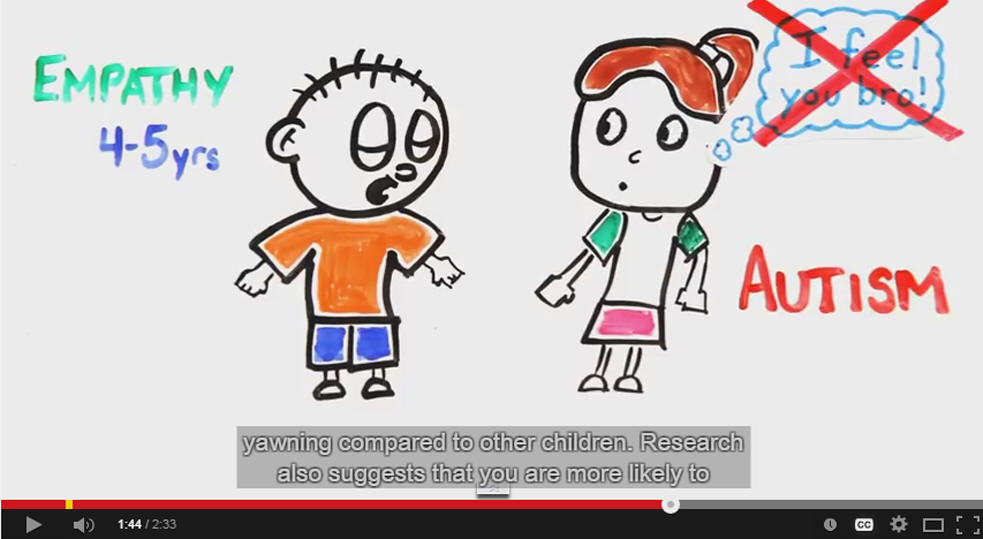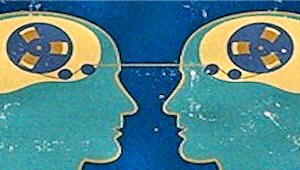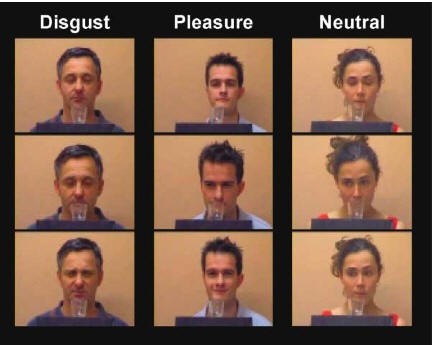|
|
|
Empathy
Tests and Measurements
Measuring Empathy
- Plato.standford.edu
'Empathic Civilization': Do We Have Empathy Or Are We
Just Good Rule Followers?
|
|||||||||||||||||||||||||||||||||||||||||||||||||
| Take the empathy test - Greater Good Science Center | |
 |
'Facial
expressions are a universal language of emotion, instantly
conveying happiness, sadness, anger, fear, and much more.
Reading these expressions is essential to compassion and
empathy. Take this short quiz to measure your emotional intelligence. ' |
Cognisess: The Emotion Test 'The Comprehensive Emotion Test will give you the most accurate and complete analysis of your ability to recognize emotions in others. It only takes about 30 minutes to complete, and it has 80 questions.' 'The Quick Emotion Test is designed for those who are pressed for time. It takes about 8 minutes to complete, and it has 20 questions'
Assessing EQ: Measuring your empathy
Emotional intelligence (empathy) is the capacity to recognize and, to some extent, share feelings (such as sadness or happiness) that are being experienced by another person. Someone may need to have a certain amount of empathy before they are able to feel compassion.
Online Test: Reading Peoples Expressions from kgajos.eecs.harvard.edu/mite/
"Test how well you can read emotions of others just by looking at their eyes. The ability to read the emotions of others is linked to "social intelligence" which, in turn, is linked to performance on team-based problem solving tasks.Quick Guide - Emotion Test
Welcome to the quick guide to the Emotion Test. The Emotion Test is part of the Global Cognitive Empathy Study. Take part today - go to www.cognisess.com
Reading the mind in the eyes (NY Times)
'For each pair of eyes, choose which word best describes what the person in the picture is thinking or feeling.
When you've answered all the questions, press the 'Get score' button at the bottom to see your results.'
For each set of eyes, choose which word best describes that the person is thinking or feeling.
'Mind Reading is a unique reference work covering the entire spectrum of human emotions. Using the software you can explore over 400 emotions, seeing and hearing each one performed by six different people.'
Emotions Library:
Learning Center:
Game: Try out the game to identify the emotions
Measurement of Affective Empathy with Pictorial Empathy Test (PET) (measurem.pdf)
"Pictorial Empathy Test (PET) consists of 7 pictures of people in distress. Subjects were asked to rate their emotional arousal in a five-point scale. It was hypothesized that seven pictures all showed variance in one latent trait, affective empathy. The fit of one-latent-factor model was assessed using structural equation modeling. PET s validity was assessed with tests of other theoretically related and unrelated concepts, such as self-reported empathy, social intelligence, intuitive thinking and gender role orientation. Correlations between PET scores and other scales were assessed to determine the validity of PET. Also, relationships between PET scores, participants sex and gender role orientation were analyzed using mediation analysis. "Reading the Mind in the Voice
More at autism research centre
Yawning test
In a group of people, if one person yawns, the first person to catch the yawn would be the most empathic.
A recent report from The Wall Street Journal’s Science Journal columnist Robert Lee Hotz, on empathy in primates and other animals (”Tracing the Origins of Human Empathy”).
(Yawning, mirroring, Frans de Wal, Kevin Ochsner, brain studies, mirror neurons, identifying with certain close groups)
Contagious Yawning Empathy Test
It has long been known that yawning is contagious among humans. Scientific studies have started to link contagious yawning with the emotional response known as empathy. Try watching this short video and count how many times you yawn.
The Yawn-O-Meter (How Long Can You Last?)
Why Do We Yawn?
Why is yawning contagious?
Video: Yaaawwwwwn* Did just reading the word make you feel like yawning yourself? Known as contagious yawning, the reasons behind this phenomenon have been attributed to both the physiological and psychological. It's been observed in children as young as four and even in dogs! Claudia Aguirre visits the many intriguing theories that might explain contagious yawning.
E for Empathy
Writing the E for Empathy on your Forehead test
Ask someone to draw a a capital E on their forehead. Do they write it so they can see it our so that others can see it?Draw the Letter E on our forehead test
Then ask him to take that extended finger and draw a capital E on his forehead. Does he draw the letter so that it faces him – that is, backward to a person looking at him? Or does he draw the letter so that the viewer can read it? Neither way is right or wrong. But the direction of that letter might tell you something about the disposition of that leader. [the more empathic person draws it so others can read it]
Self-rating & Self Assessment Tests
Empathy Quiz at Greater Good
"The quiz contains a total of 28 questions. Please answer them as honestly as possible--there are no right or wrong answers. The first 22 will be used to measure your level of empathy; the last six will be used by our research team to understand how empathy relates to factors like gender, birth order, and political orientation. "
Empathy Quotient Test by Simon Baron-Cohen 'Read each of the following 60 statements very carefully and state how strongly you agree or disagree with it. When you've answered all the questions, press the 'Get score' button at the bottom to see your results. Professor Simon Baron-Cohen test'
img http://en.wikipedia.org/wiki/Exams
This is an combined version of Baron-Cohen's Empathizing Quotient (EQ) and Systemizing Quotient (SQ) tests.
"The Empathizing–systemizing theory was developed by Simon Baron-Cohen and holds that different individuals have a biologically determined inclination towards a brain structure optimized to either use "empathizing" or "systemizing" as its primary mode of interacting with the world. "Science of Empathy
'Autism expert Professor Simon Baron-Cohen reveals the science behind "the world's most valuable resource" – and how its lack is the root of human cruelty'
See how you fare in our empathy test
The University of Michigan test - American college students test
Changes in Dispositional Empathy in American College Students Over Time: A Meta-Analysis
Personality and Social Psychology Review Sara H. Konrath, Edward H. O'Brien, Courtney Hsing "The current study examines changes over time in a commonly used measure of dispositional empathy. A cross-temporal meta-analysis was conducted on 72 samples of American college students who completed at least one of the four subscales (Empathic Concern, Perspective Taking, Fantasy, and Personal Distress) of the Interpersonal Reactivity Index between 1979 and 2009"Social perspective taking: A multidimensional approach
HGSE Assistant Professor Hunter Gehlbach
Gehlbach and HGSE doctoral students Maureen Brinkworth, Ming-Te Wang, and Christopher Wynne have developed a test to measure perspective taking ability – and they invite you to try it. Watch this video of a conversation between Gehlbach and Brinkworth, and then answer the short list of yes-or-no questions below. Then click the submit button, and find out how skillfully you can recognize the feelings that underlie other people's words, gestures, and expressions.
Qualtrics Survey
'Please answer ALL of the questions below and when you are done, you will see a screen with your score on it. You will learn how you compare to almost 14,000 college students on empathy. '
Empathy quotient test
Read each of the following 60 statements very carefully and state how strongly you agree or disagree with it. When you've answered all the questions, press the 'Get score' button at the bottom to see your results.
Systemizing quotient test
Read each of the following 60 statements very carefully and state how strongly you agree or disagree with it. When you've answered all the questions, press the 'Get score' button at the bottom to see your results.
Autism Spectrum quotient test
Read each of the following 50 statements very carefully and state how strongly you agree or disagree with it.
Levels of Empathy
'Empathy can be difficult to measure, so an "empathy scale" is often used by psychologists to characterize degrees of empathy during our verbal exchanges with others.Level 1: Tuned Out
Level 2: Reptilian or Pretend Listening
Level 3: Connection
Level 3: Advanced Level'
'The following test measures one's empathy level. Empathy is the ability to feel and comprehend other people's emotions. An empathic person performs an active effort to get in tune with another person, leaving out personal aptitudes such as sympathy, antipathy, fondness and moral judgments.'
Test how self-compassionate you are
'Please read each statement carefully before answering. To the left of each item, indicate how often you behave in the stated manner, using the following scale'
Are you an Empath? Take the test and find out!
'This test scores you on several categories, including: whether you are an Out of Control Healer, how well you use your own Empathic Protection Tools, how much you Unconsciously Mirror other people, and how Logical vs Intuitive you are. '
What’s your EQ (empathy quotient)? pdf
'This quiz, adapted from a common psychological test of empathy, gauges two key empathy types: concern for others and perspective (the ability to imagine someone’s point of view). For each question, pick a number from 1 to 5, then tally your scores.'
Self-Assessment 3.10: Assessing Your Emotional Empathy
"The source of this scale is: M. H. Davis, "A multidimensional approach to individual differences in empathy," JSAS Catalog of Selected Documents in Psychology, 10 (1980), p. 85.
This self-assessment is designed to help you to estimate your propensity for emotional empathy. It includes 7 statements, and you are asked to indicate the degree to which each statement does or does not describe you very well. You need to be honest with yourself to for a reasonable estimate of your level of perspective taking."
The parental empathy measure: a new approach to assessing child maltreatment risk. Kilpatrick
"A new operational definition of parental empathy and a new instrument, the Parental Empathy Measure (PEM), are introduced. With a sample of 103 parents (50 registered maltreating, 32 matched distressed, and 21 matched controls), the PEM demonstrated good internal consistency, very good interrater reliability, good construct validity, and very good concurrent validity."
INTERPERSONAL REACTIVITY INDEX (IRI
Davis, M. H. (1980). A multidimensional approach to individual differences in empathy.
JSAS Catalog of Selected Documents in Psychology, 10, 85.
Second Person
Assessment Test
"Clients are better judges of the degree of empathy than are therapists.
(Expert from Carl Rogers Empathic: An Unappreciated Way of Being. This is related to therapists being bad judges of their quality and degree of empathy. This could be applied to anyone)Perhaps then it is not too surprising that therapists prove to be rather inaccurate in assessing their own degree of empathy in a relationship. The client's perception of this quality agrees rather well with that of unbiased judges listening to the recordings, but the agreement between clients and therapists, or judges and therapists, is low (Rogers, Gendlin, Kiesier and Truax, 1967, Chs. 5, 8). Perhaps, if we wish to become better therapists, we should let our clients tell us whether we are understanding them accurately!"
Ask others to Assess You
Observer rating
(third person assessment)
Development of the Therapist Empathy Scale.
"BACKGROUND: Few measures exist to examine therapist empathy as it occurs in session.
AIMS: A 9-item observer rating scale, called the Therapist Empathy Scale (TES), was developed based on Watson's (1999) work to assess affective, cognitive, attitudinal, and attunement aspects of therapist empathy. The aim of this study was to evaluate the inter-rater reliability, internal consistency, and construct and criterion validity of the TES.
METHOD: Raters evaluated therapist empathy in 315 client sessions conducted by 91 therapists, using data from a multi-site therapist training trial (Martino et al., 2010) in Motivational Interviewing (MI).
CONCLUSIONS: The TES demonstrates excellent inter-rater reliability and internal consistency. RESULTS indicate some support for a single-factor solution and convergent and discriminant validity. Future studies should examine the use of the TES to evaluate therapist empathy in different psychotherapy approaches and to determine the impact of therapist empathy on client outcome."
Peer Rating
Carl Rogers mentions a rating of therapists empathy by a panel of 83 other therapists. I don't know what the criteria they used was. Mentioned in Empathic: An Unappreciated Way of Being
"Raskin (1974) showed that when the recorded interviews of six experienced therapists were rated by other experienced therapists, the differences on twelve variables were significant at the .001 level, and empathy was second in the extent of difference. The outstanding characteristic of the client- centered therapist was his empathy. Other approaches had as their outstanding characteristic their cognitive quality, or therapist-directedness, and the like. So, though therapists regarded empathic listening as the most important element in their ideal, in their actual practice they often fall far short of this. In fact the ratings of the recorded interviews of these six expert therapists by 83 other therapists came up with a surprising finding. In only two cases did the work of the experts correlate positively with the description of the ideal therapist. In four cases the correlation was negative, the most extreme being a -.66! So much for therapy as it is practiced!"
Measure of Expressed Empathy - Meichenbaum
"Thinking back to the demonstration of Don Meichenbaum with Richard, please rate him on the following dimensions from 'never' to 'all of the time':
1. * Does the therapist’s voice convey concern? ( ) Never ( ) 25% ( ) Half of the Time ( ) 75% ( ) All the Time "
etc. to 7.
Measuring Bodily Functions, Chemicals, etc
Carl Marci Measurements
Physiology and Neurobiology of Empathy
Dr. Carl Marci will discuss aspects of empathic connection using the latest findings from his research with peripheral measures of central nervous system activity. Additional studies using neuroimaging to understand the latest in empathy research will also be presented.The Look of Love - Love's many splendors begin with empathy and attachment
Video: Carl Marci discusses "Neurobiology and Physiology of Empathy"
Carl D. Marci, MD, Director of Social Neuroscience for Psychotherapy Research Program, Massachusetts General Hospital; Instructor in Psychiatry, Harvard Medical School
Measuring Oxytocin Levels
Oxytocin Enhances Amygdala-Dependent, Socially Reinforced Learning and Emotional Empathy in Humans
'Oxytocin (OT) is becoming increasingly established as a prosocial neuropeptide in humans with therapeutic potential in treatment of social, cognitive, and mood disorders. However, the potential of OT as a general facilitator of human learning and empathy is unclear. ...A general conclusion from our results is that treatment with an OTR agonist may be a useful therapy in enhancing socially motivated learning and emotional empathy in men. '
Measuring Testosterone Levels
A new study for the first time has provided hard data on how administering testosterone under the tongue (sublingually) negatively affects an important marker for empathy.
2D:4D ratio. finger Ratio
Digit ratio - Wikipedia
Hand with index finger being shorter than the ring finger, resulting in a small 2D:4D ratio, pointing to a high exposure to testosterone in the uterus.
Genetic Markers for Oxytocin ReceptorsTelltale Signs You’ve Got the ‘Love Hormone’ Gene?
Research has shown that people with two G variants of the gene are more empathetic and “prosocial,” showing more compassion, cooperation and positive emotion. In contrast, those with the at least one A version of the gene tend to be less empathetic, may have worse mental health and are more likely to be autistic.
fMRI
Side by side image scan of two people. One person does an action, how close is that mirrored in the other persons brain activity as measured by fMRI?
Empathy with Christian Keysers on BBC
Christian Keysers explains how empathy can be measured using fMRI. From the TV series 'The Brain: A secret history
Mirror neurons also seem to be involved in empathy, a much more complex and ambiguous aspect of observing others. This idea has prompted a great deal of excitement and speculation, as some look to empathy as one of the most fundamental and unique things that make us human.
Empathy describes our ability to understand and feel another's emtions as our own, giving rise to such sayings as 'I feel your pain.' As we will see, this is not just a figure of speech, but appears to have a basis in neural physiology.
Self-Empathy & Self-Compassion Tests
Kristin Neff - Self-Compassion.org Test
'Please read each statement carefully before answering. To the left of each item, indicate how often you behave in the stated manner, using the following scale:
( ) 1. I'm disapproving and judgmental about my own flaws and inadequacies.
...( ) 26'The Development and Validation of a Scale to Measure Self-Compassion PDF
'This article defines the construct of self-compassion and describes the development
of the Self-Compassion Scale. Self-compassion entails being kind and understanding
toward oneself in instances of pain or failure rather than being harshly self-critical;
perceiving one’s experiences as part of the larger human experience rather than
seeing them as isolating; and holding painful thoughts and feelings in mindful
awareness rather than over-identifying with them'
Others
'The Voight-Kampff test attempts to distinguish androids from human beings by autonomic responses to questions that should elicit an empathic response. Because it seeks to gather and measure biological information for security purposes, the empathy testing procedure is a kind of biometric identification system.'
Video: Blade Runner: Voight-Kampff
"Is this to be an empathy test? Capillary dilation of the so called blush response. Fluctuation of the pupil? Involuntary dilation of the iris?
We call it Voight-Kampff for short."
Video: Blade Runner - Deckard Meets Rachel Pt 2 (Voight-Kampf Test)
Video: Blade Runner VK Test on Leon
"I'm going to ask you a series of questions, just relax and answer them as simply as you can. It's your birthday, someone gives you a cat skin wallet?
I wouldn't except it. Also, I'd report the person that gave it to me to the police."
